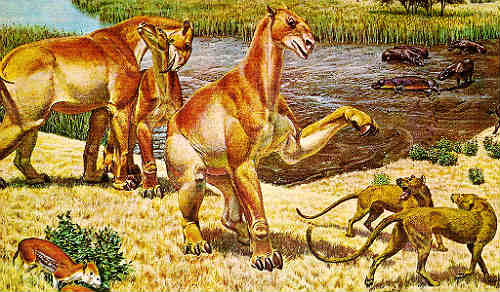Bear-cow Hybrids?
Mammalian Hybrids
|
A diligent scholar is like a bee who takes honey from many different flowers and stores it in his hive.
—Henry David Thoreau, Walden
|
This cross is rather similar to dog × cow, but there are not as many reports documenting its occurrence, perhaps because bears are not domestic animals and are much less common than dogs and therefore come into potential breeding contact with cattle far more rarely than do dogs. Nevertheless, an unexpectedly large number of such reports have been found. All involve cattle mothers (as is the case for dog-cows).
Many reports about bear-cows describe full-term fetuses that were either stillborn or that died when their mother was slaughtered. But the following report describes a fully viable hybrid. It appeared in The Clifton Clarion (Nov. 9, 1887, p. 1), a newspaper published in Clifton, Arizona:
Strange Freak
During the recent round-up in Tonto Basin [in Gila County, Arizona], among the cattle driven in for branding was a strange monstrosity in the shape of a yearling heifer, bearing the head of a bear† adorned with incipient horns. The animal was not over two feet in height, owing to the shortness of its legs, which terminated in peculiar shaped hoofs which were split like those of other bovine animals. Each hoof was about five inches long and was formed of two parts, the outer one being nearly two inches longer than the inner. In other respects the brute seemed to be perfect, with the exception of the hair, which was unusually long and resembled closely in appearance that of a bear. The mother of the monstrosity was in no way remarkable and appeared to regard with the utmost favor her strange offspring. As the mother bore the brand of John V. Meadows, one of the leading stockmen in the Basin, the same iron was placed on the calf, which was again turned loose on the range. It is thought that this strange freak of nature is owing to the mother having been frightened by a bear during pregnancy.
The year after the publication of the report quoted above, the following one-sentence notice appeared in the Pottsville, Pennsylvania, Republican (May 21, 1888, p. 1, col. 6):

This report is from the Munster, Indiana, Times (Oct. 29, 1923, p. 7, col. 7; ||y39zb8o8):
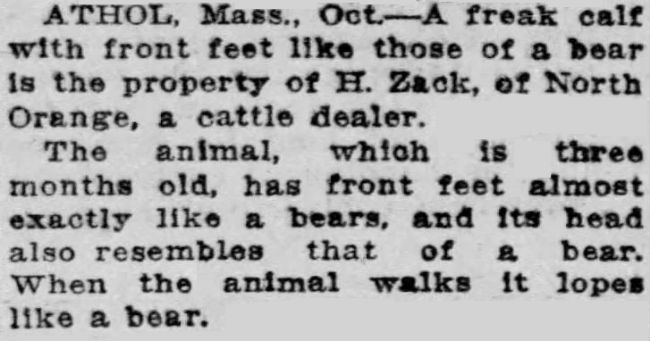
The report reproduced below is from the Montpelier, Vermont, Evening Argus (Apr. 29, 1918, p. 5, col. 4; ||yy6lt2d9):
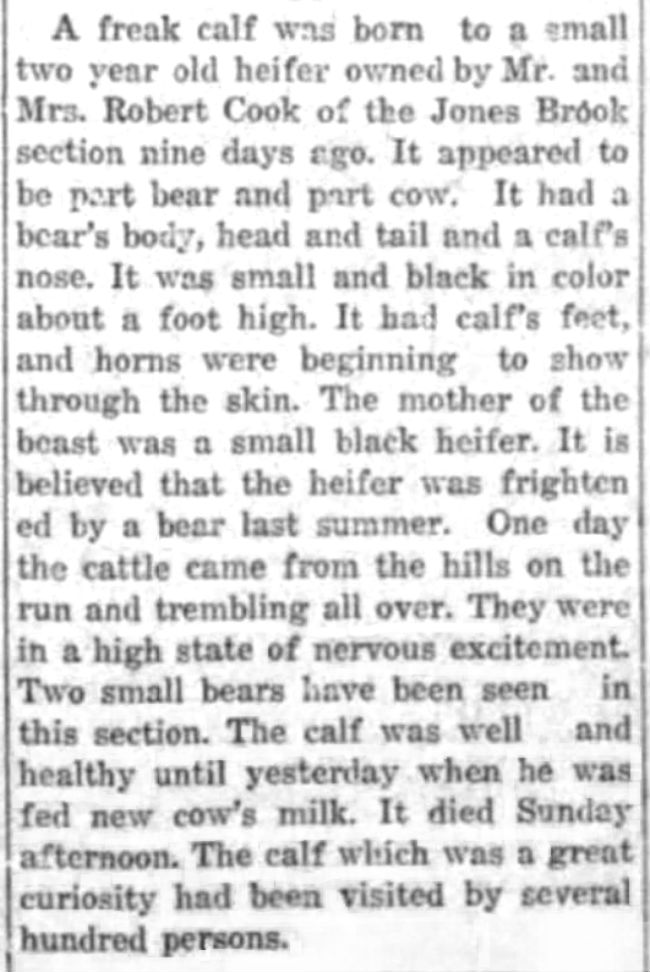
Another report, about an apparently viable bear-calf that had been born near Wausau, Wisconsin, appeared in the Appleton, Wisconsin, Crescent (May 24, 1873, p. 4, col. 5; ||y2ullpnn):
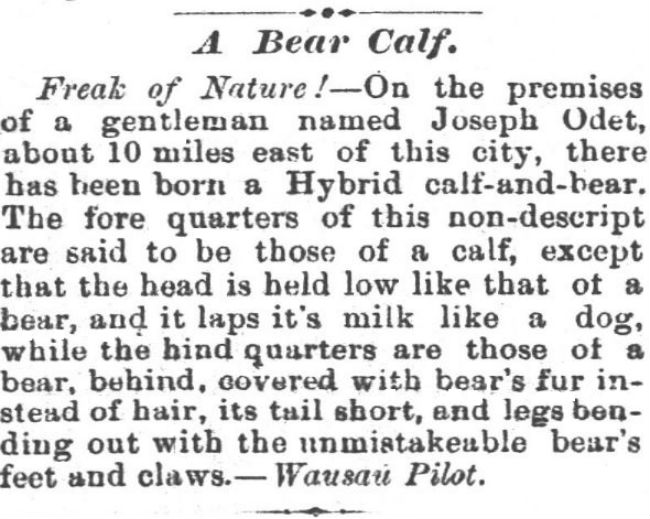
One German-language report comes from Košice, the largest city in eastern Slovakia, which was part of the Austro-Hungarian Empire prior to World War I. It appeared in the Viennese newspaper Welt Blatt (May 16, 1877, p. 7, cols. 2 and 3):
Cow Pregnant with a Bear
From Košice: On the 6th of this month, a veterinarian† residing at Košice, Herr Kaiser, was called to the nearby village of Buza where the pregnant cow of a farmer, named Glück, had been unable to calve despite all efforts to assist her. When even the vet couldn’t help, she had to be slaughtered. And what was inside! Instead of a calf, the assembled farm workers were amazed to find a fully formed bear cub weighing 60 Viennese pounds (i.e., 74 lbs or 33.5 kg). It had a long-haired, shaggy coat and resembled a calf only in the upper portion of its face. The nasal bones were absent and it was a cyclops with a single eye in the center of its forehead. At the urging of the veterinarian, this remarkable monstrosity was taken to Košice. [Translated by E. M. McCarthy. Original German.]
Another bear-cow hybrid shambled onto the pages of Welt Blatt (May 18, 1878, p. 9, col. 1) the following year:
Cow births Monster
From Hersbruck in Bavaria: Yesterday, in the little neighboring town of Velden, the cow of the bailiff there could not calve and, despite the help of a veterinarian, she could not be saved. And when they cut open the body, there came to light a thing that no one in these parts had ever seen before, which honestly had the following appearance: The head was like that of an unusually large pug dog. The neck was nonexistent. The body was covered with the long hair of a bear and, overall, was formed like that of a bear, with a bear’s short tail. Only the feet were those of a cow. The creature is completely developed and would, perhaps, have lived if the mother had not been slaughtered. [Translated by E. M. McCarthy. Original German.]
Hersbruck is about ten miles east of Nuremburg.
Another such report, but briefer, appears inthe same newspaper, Welt Blatt (Mar. 29, 1887, p. 5, col. 1):
Quintuplets
From Volders‡ in the Tyrol it’s reported that in Riccabonahofe near Volders, on the 21st and 22nd of this month, a cow gave birth to five stillborn calves. Four were of ordinary appearance, but the fifth was a so-called bear-calf. The mother cow is, however, doing just fine. [Translated by E. M. McCarthy. Original German.]
Another, more recent notice published in a newspaper published in 1943, states that “bear-calves [i.e., Bärenkälber] are found in the abortions of cattle.”
If these European reports are genuine, then one would have to assume that the male parent of this hybrid was a brown bear, Ursus arctos, the only bear in Europe.
It is true that a detailed newspaper report exists about bear-goat hybrids (quoted elsewhere on this website), which is a similar cross. But the actual occurrence of that cross, has not been established either. There is also a report about a bear-sheep hybrid, and even a rather detailed report about a bear-horse hybrid.
The following appeared in the Sacramento, California, Daily Union (May 7, 1874):
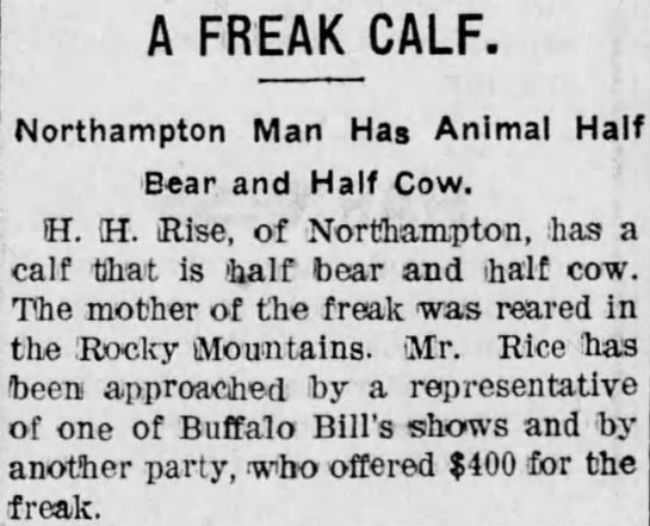 A news report about a bear-cow hybrid at Northhampton, Pennsylvania (Lebanon, Pennsylvania, Courier and Semi-weekly Report, Apr. 26, 1910, p. 2, col. 4; ||y2bohvbh)
A news report about a bear-cow hybrid at Northhampton, Pennsylvania (Lebanon, Pennsylvania, Courier and Semi-weekly Report, Apr. 26, 1910, p. 2, col. 4; ||y2bohvbh)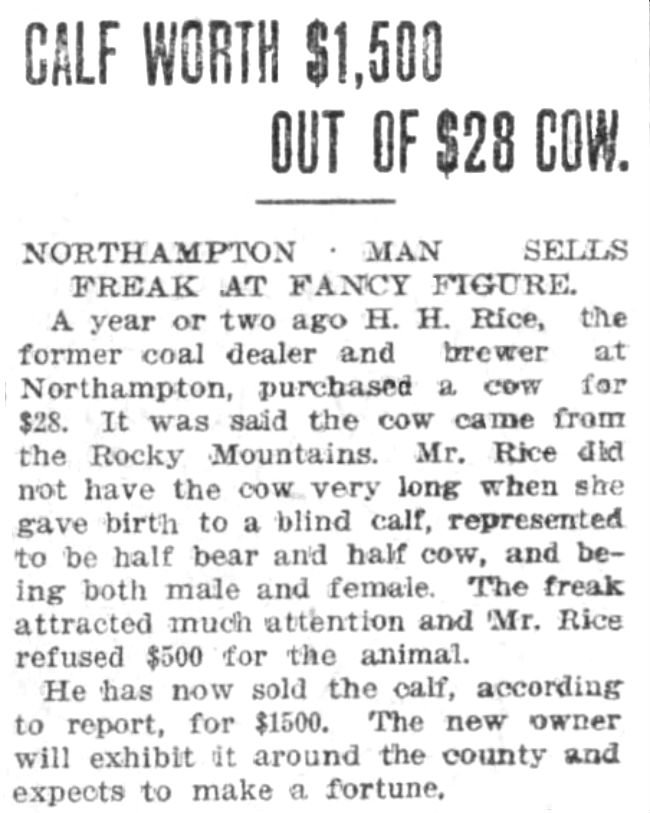 A subsequent report about the owner selling the bear-cow hybrid at Northhampton, Pennsylvania (Allentown, Pennsylvania, Leader, Feb. 18, 1911, p. 11, col. 5; ||y2ajnm5x)
A subsequent report about the owner selling the bear-cow hybrid at Northhampton, Pennsylvania (Allentown, Pennsylvania, Leader, Feb. 18, 1911, p. 11, col. 5; ||y2ajnm5x)
An additional report, from Canada, appeared in the St. John, New Brunswick, Daily Sun (Apr. 25, 1904, p. 2, col. 1). This location excludes the potential participation of U. arctos in the reported cross and instead implicates the American Black Bear (Ursus americanus), the only bear that occurs in eastern Canada. Hybrids between Ursus americanus and U. arctos have been produced in captivity (see the bear hybrids page). Originally published in a Fredericton newspaper, The Daily Gleaner, the notice in question is very brief and reads as follows:
Freak of Nature
There has been born in St. Marys* an animal which is causing considerable attention. Its mother is a cow and is half calf and half bear. Its head and neck are shaped similarly to a bear’s, and it has two tails, one similar to a calf’s on its side and the other similar to a bear’s attached at the regular place.
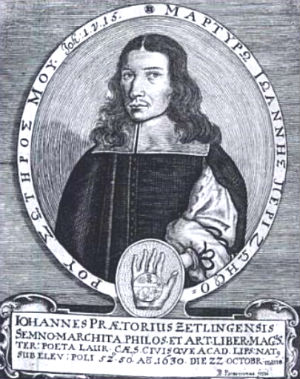
A brief notice reporting another such event appeared in the Watertown Times (May 8, 1891, p. 8, col. 1), a newspaper published in Watertown, New York: “In the town of Worth, this county [i.e., Jefferson County, New York], is to be seen a monstrosity, half calf and half bear.”
In addition, on page 3, column 3, of the August 21, 1890, issue of the Crawford Avalanche, a newspaper published in Grayling, Michigan (source). A cow is reported to have given birth to a bear cub at Rust Township, which is in the northeastern part of Lower Michigan.
So now an important question arises: If a cow can bear such young, then could a bear cow such young as well?
By the same author: Handbook of Avian Hybrids of the World, Oxford University Press (2006).
The origin of chalicotheres? One correspondent wrote in to suggest that a bear-horse hybrid would have traits characteristic of the extinct ungulates known as chalicotheres. One such creature, Moropus, was endemic to North America during the Miocene from ~23.0—13.6 Mya (an artist’s reconstruction is shown below).
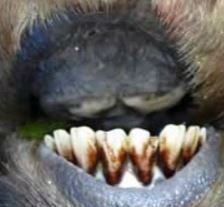 Dental pad of a moose.
Dental pad of a moose.
I tend to agree with this suggestion in a general way, at least to the extent that I think it should be investigated further, but one issue is that chalicotheres apparently lacked upper incisors, which is an artiodactyl trait, and not one of perissodactyls. Instead, the lower incisors pinch food such as grass and twigs against a dental pad on the upper mandible (see image right). So the present cross, bear × cow, might come a little closer to fitting the bill. However, it’s not easy to judge the likelihood of such a hypothesis, given that available descriptions of alleged bear-cows lack detail.
† The German word used was Kurschmied, a now defunct profession that combined the duties of veterinarian and farrier.
